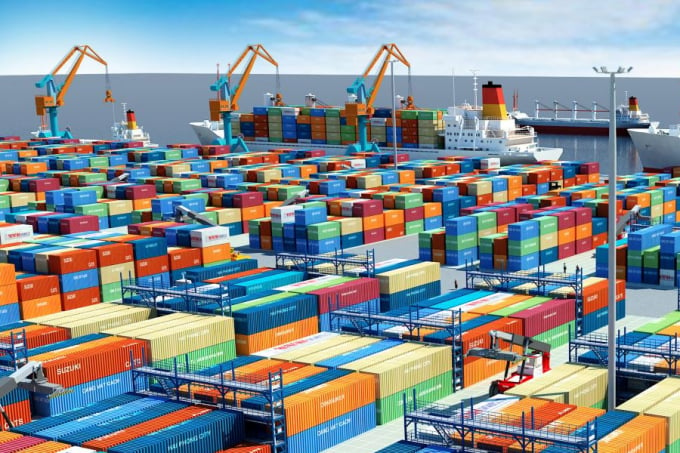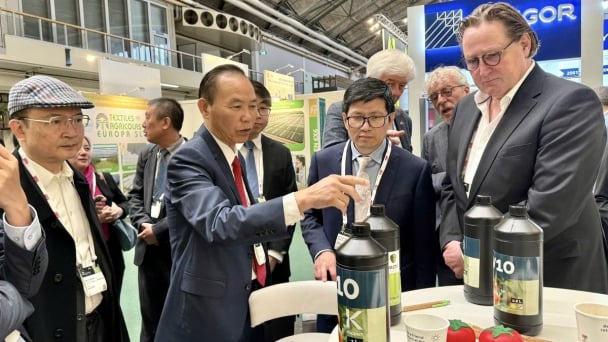June 14, 2025 | 11:16 GMT +7
June 14, 2025 | 11:16 GMT +7
Hotline: 0913.378.918
June 14, 2025 | 11:16 GMT +7
Hotline: 0913.378.918

Mr. Nguyen Hoai Nam, Deputy General Secretary of VASEP spoke at the Forum. Photo: Bao Thang.
Vietnam's logistics industry has made strong developments in recent years. As a result, the World Bank's most recent logistics performance index ranked Vietnam 39th out of 160 countries and third in Southeast Asia. This is the highest result that Vietnam has ever achieved.
Sharing about this issue at the Forum "Development of Vietnam's logistics industry with Europe - America region" organized by the Ministry of Industry and Trade on December 17, Mr. Nguyen Hoai Nam - Deputy General Secretary of Vietnam Association of Seafood Exporters and Producers (VASEP) said: "Logistics development creates a competitive advantage, especially in the time when the world recovers from the pandemic".
VASEP leaders said that Vietnamese exporters have had to face many challenges in terms of costs and increased logistics charges over the past time. It makes it difficult for businesses to take advantage of the "golden opportunity" during the peak production season at the end of the year when the demand for food is high in European and American markets.
Mr. Nam synthesizes these barriers into "5-increase principles" - including the increase in freight rates; increase in fees; increase in transit time; increase in the frequency of flight delays and cancellations, and increase in costs incurred.
For example, freight from Vietnam to the US, before Covid-19, the highest freight rate was US$ 3,500, but now it ranges from US$ 12,000 to US$ 14,000 per container. Similarly, freight rates to the Middle East also jumped from US$ 1,000 to US$ 1,500, then to US$10,000, and US$11,000 per container.
The shipping time also increased from 7-10 days on average. In particular, according to Mr. Nam, seafood businesses have delayed orders for up to 2-3 months. Moreover, while waiting to load empty containers, companies also have to pay additional fees such as clean fuel, container balancing, port jam, etc.
"There is no other way; businesses are forced to increase their resources. During and after the epidemic, the solution focuses on logistics. We have suggested businesses need to strengthen contracts with large transport businesses to ensure time", Mr. Nam said.
Sharing the same opinion with Mr. Nam, experts all said that investing in logistics infrastructure is highly urgent, emphasizing the development of multimodal transport. Besides the sea, rail and inland waterway transport development is also very urgent.

The problem many exporters have encountered in recent times is the lack of containers.
Mr. Rolando Alvarez Viera, Vice President of the Federation of International Freight Forwarders Associations (FIATA), advises state management agencies and businesses to focus more on digitization and automation. In particular, the development of a single-window trade mechanism, a paperless process, needs to be brought up with customs.
Another solution emphasized by Mr. Rolando is that businesses should have a plan to prioritize near-shore mechanisms. For example, if a business needs to transport goods to Northern Europe, it should choose a transshipment point in the Netherlands or Germany. The meeting point should be located in Spain or Morocco if going to Southern Europe. It helps businesses reduce risks in circulation.
When choosing a gathering point, FIATA leaders also gave seven selection criteria: (1) logistics connectivity; (2) the stability of the political sector; (3) social stability; (4) the host country's monetary policy; (5) transport infrastructure; (6) geographical location; (7) convenience in transit.
Noting the comments, Deputy Minister of Industry and Trade - Mr. Do Thang Hai commented that logistics is one of the fastest-growing and most stable industries in Vietnam, with an average growth rate of 14-16% per year, contributing contribute to GDP from 4 to 5%.
The whole country has about 30,000 enterprises operating in logistics, with approximately 5,000 professional enterprises. "Those are good signs for the development prospect of Vietnam's logistics industry," said Mr. Hai.
In the 4.0 era, 4.0 solutions in logistics, especially logistics for e-commerce, were also discussed at the forum.
With the perception that cross-border e-commerce is becoming a core factor of the global economy and an inevitable trend that no country can stay out of, the speakers focused on analyzing the current status and giving recommendations to develop an e-logistics system for Vietnamese enterprises to seize export development opportunities through cross-border e-commerce promptly.
Translated by Ha Phuc

(VAN) The Department of Agriculture in South Africa has announced the country’s first mass vaccination of poultry to prevent local birds from contracting avian influenza.

(VAN) Establishment of the Mekong Delta Regional Agricultural Linkage Center, aiming for a closed value chain, deep processing, trading platforms, and international market connectivity.

(VAN) Gia Lai province has recently recorded 460 rare species of animals and plants, contributing to forest conservation and biodiversity planning in the region.

(VAN) Ms. Caroline Beresford, New Zealand Ambassador to Vietnam, expressed confidence that agricultural cooperation between Vietnam and New Zealand will develop sustainably, be climate-resilient, and promote gender equality.

(VAN) Vietnam reaffirms its commitment to international cooperation in fostering sustainable and responsible fisheries while ensuring resilient livelihoods for small-scale fishing communities.

(VAN) More than just a technical solution, science and technology are gradually becoming a cornerstone in Vietnam’s journey toward building a circular economy.

(VAN) The Netherlands is ready to accompany Vietnam in building a green, circular, and sustainable agriculture sector that is resilient to climate change.